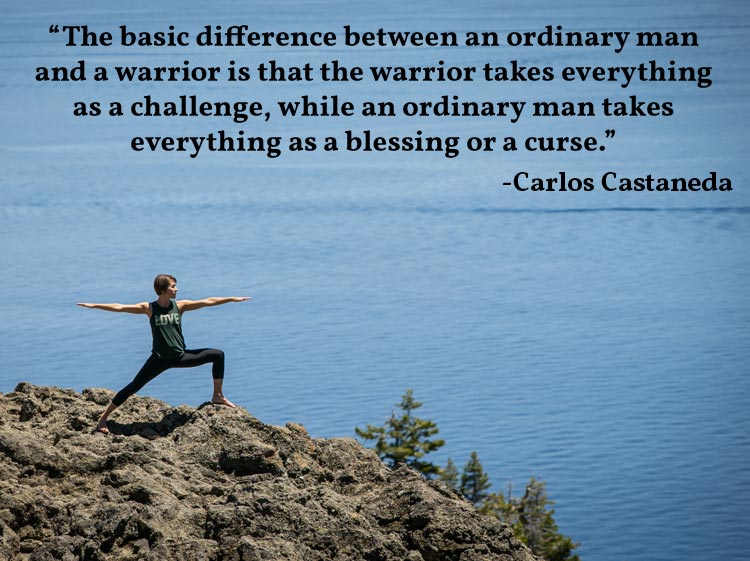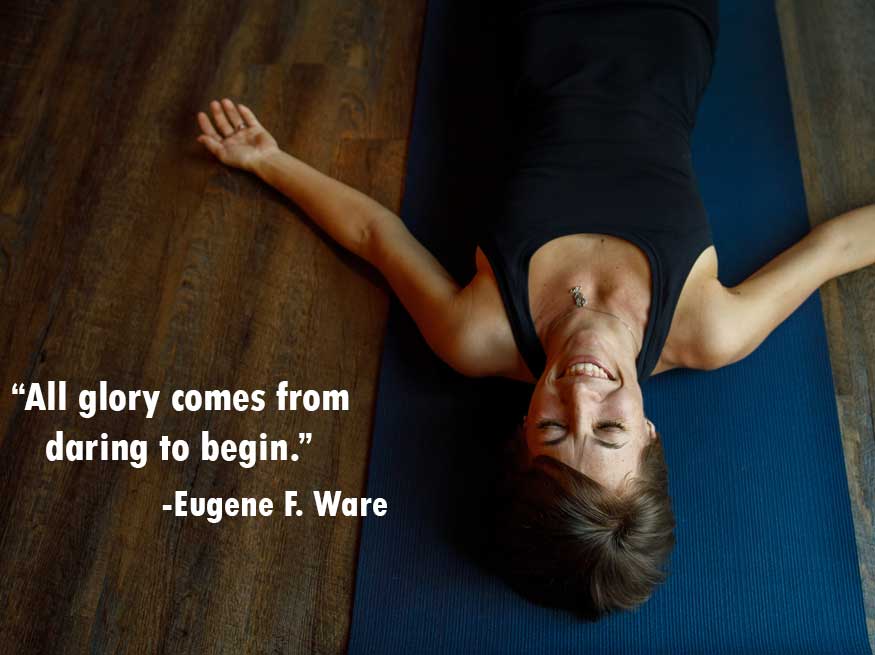 One of the most powerful skills as a teacher is the ability to design a memorable experience for students on the yoga mat. You create sequences to move the body safely through postures, but you use yoga class themes to focus the mind and elevate the spirit. Below you’ll find 20 great ideas you can seamlessly weave into your classes today!
One of the most powerful skills as a teacher is the ability to design a memorable experience for students on the yoga mat. You create sequences to move the body safely through postures, but you use yoga class themes to focus the mind and elevate the spirit. Below you’ll find 20 great ideas you can seamlessly weave into your classes today!
When you do this, you help students:
- Understand the direction of your class
- Clarify the intentions of their practice
- Find meaning behind the physical postures
- Generate insights about themselves and their lives
- Identify you as their guide on their journey
- Feel connected to you as a fellow traveler on the yogic path
Plus, yoga class themes support the verbal cues you give as an instructor. Themes can help you keep your words succinct and on topic. This level of clear communication will build trust between you and your students, and make your time together more beneficial for all.
(1) ONE STEP AT A TIME
Vinyasa krama is all about taking conscious steps in the right direction. It’s the way in which you consciously move your body, direct your thoughts during practice, and move toward your goals incrementally.
Yoga is an unending path, and vinyasa krama reminds you to enjoy each step of the journey. So how can you find more appreciation, poise, and curiosity on your mat today–no matter where you are on life’s adventure?
(2) BREAK BAD HABITS AND EMBRACE YOUR BEST SELF
Have you ever felt like your habits were controlling you instead of the other way around? If these are good habits, then it’s not a problem. But, if it’s an old habit you want to change, doing so can seem tough. Thankfully, yoga is a practice that allows you to un-memorize negative emotional patterns associated with unwanted habits.
Each time you step on the mat, you’re invited to embrace your best self. You are encouraged to heighten your awareness of thoughts and body sensations. And, you uncouple experiences of the past from the present moment–giving you a chance to be free and powerful in the ever-present now!

Photo Credit: Stephen Leonardi
(3) CELEBRATE SMALL VICTORIES
Yoga–like a well-conceived game–provides a structure where you can test your mental and physical prowess. Like any good game, it feels great to win. Only the game of yoga doesn’t really end, so how do you incorporate that feeling of victory from time to time?
Invite students to celebrate their progress. Encourage them to pause and notice their strength in class. You might even send them a personalized card acknowledging their accomplishment of a new pose. Instead of growing weary in the practice, keep the love for the game of yoga alive by demonstrating the many ways they win by just being on the mat!
(4) BEGINNER’S MIND
The concept of beginner’s mind originates from the Zen practice of meditation. It’s a mindset you can use to approach any situation without set expectations. Then, without forcing any action to produce a certain result, you can relax into the natural unfolding of the experience.
So whether you really are new to yoga, or you have practiced hundreds or thousands of times, how can you view it as a new experience. How can you release ideas of the past and be open to new possibilities on your mat?
As Shunryu Suzuki so eloquently stated, “In the beginner’s mind the options are many. In the expert’s mind the options are few.” Today, enjoy the many options that are available to you by shifting into beginner’s mind.
(5) ABYASA VAIRAGYA
Abyasa Vairagya is a Sanskrit term that refers to the perfect balance of effort and surrender when approaching your yoga practice. Essentially, abyasa translates to a persevering practice, one that is fueled by the fire of discipline. Vairagya refers to a sense of non-attachment to the outcome. This requires an inner sense of contentment as you make progress down your path, no matter where you find yourself on the journey today. Both comprise two sides of one coin that allow you to sustain your increased awarenesss, inner calm, and passion over time.
(6) EMBRACE YOUR IMPERFECTIONS
Unlike the static images on social media that portray yoga as a beautiful, graceful and refined practice, there are many elements of it that are not those things. We fall. We fart. Our faces reveal our challenges and discomfort at times. In essence, it’s full of imperfections.
Embrace these moments. For as Don Juan said in Tales of Power “The basic difference between an ordinary man and a warrior is that the warrior takes everything as a challenge, while an ordinary man takes everything as a blessing or a curse.”
Embrace your imperfections as a way to grow and learn and change for the better in each moment!

Photo Credit: Diane Nicole Photography
(7) YOUR MAT AS A DOJO
In the martial arts world, the practice hall is called a dojo. It’s a place where you go to practice being the best you can be. And while it might appear that one person is combating another, each person is really battling the personalities within themselves.
Your mat provides you the same opportunity. Essentially, yoga asana is an idea and the postures come to life when you bring your energy to it on the mat. Each pose offers you a choice–to be sloppy or precise. You can be thoughtful or inconsiderate. Or, you can be disconnected or aware. In each moment, you can decide to let your best self hide, or come to the forefront of your life.
(8) VILOMA – GOING AGAINST THE GRAIN
Viloma pranayama is a practice used to consciously change the pattern of the breath. But, it’s also a theme you can use to shift the way you look at something familiar. Invite your students to view the habitual tendencies of society through new eyes. Encourage them to feel lighter against the downward pull of gravity. Ask them to question the negative thoughts that arise in their mind and discover which ones actually align with their best self. This can be a powerful practice to break through barriers and move into new ways of living and being.
(9) TURN YOUR GAZE INWARD
With 80% of our sensory input coming from the eyes, it can be easy to focus the attention on our outward surroundings. Instead, turn the gaze inward (umpada dristi) by closing the eyes during portions of the practice. Allow the sensations of the body to bring new life into each posture. Encourage the ears to hear your internal dialogue more clearly. Above all, observe the level of trust you have within yourself to move and find balance with more ease than you thought possible. Then, this level of inner confidence can be projected back into the outer world as you move off of your mat and into the various areas of your life.
(10) BROADEN YOUR PERSPECTIVE
While each of us can never fully see the world from someone else’s point of view, each us wants to be understood and valued. Pratipaka-Bhavana is the principle of looking at the other side of a story. It’s about listening to another’s input and opinion–all while avoiding judgment and seeking the truth. How might you deepen your understanding of others today?
(11) EXPAND YOUR CAPACITY FOR SUCCESS
Fear is one of the biggest barriers to success, and this internal angst can manifest in many ways. It can lead you to believe you’re unreliable or imperfect. Or it can make you feel like a burden, or even guilty if you shine too bright. Yet yoga helps you overcome these limiting beliefs by revealing their true nature. The physical strength you cultivate on the mat increases your courage, and the flexibility you generate allows you to be open to how success arrives in your life. For your capacity for success is endless, and yoga helps you embrace it on a daily basis!

Photo Credit: Emerson Peters
(12) CHOOSE A PATH TO LOVE
The sages from the Vedic texts were among the first to map out the path to love. They called this Sadhana. Since a path indicates there is a beginning, they would say that the journey starts with a longing to experience love.
Although it’s our true nature, it is often clouded by fear or anger or hatred. The end of the path is where nothing but love is experienced. Some get to this endpoint in their lifetime. Many find it when they leave their physical bodies.
But you have the chance to find it today when you choose to take a posture from a place of love vs judgement. You can also discover sadhana when you appreciate your practice instead of dread it. So, how will you choose a path to love on your mat … and beyond?
(13) ACKNOWLEDGE YOUR INNER LIGHT
Kaivalya is the state where you are not affected by any past conditioning of the heart and mind. This means that the inner light of awareness shines so brightly through you that compassion, non-violence, virtue and other positive attributes infuse any action you take. While Kaivalya cannot be fully understood with words, it can be experienced via direct connection with Source. You can tap into this knowing with each breath, each movement, and each thought. And, you can recharge your energy levels by acknowledging this light during your practice!
(14) APPRECIATE YOURSELF
The Mantra Om Namah Shivaya means that “I bow to the inner self.” Broken down into its respective parts:
- OM = the infinite vibration of All that Is
- Namah = to bow
- Shivaya = both Shiva, and beyond that, the inner self.
Essentially, this mantra is a love song for yourself, for the importance of your experience here on Earth, and the immense value you provide in the evolution of life in its broadest sense. And, you can pair this class theme with forward folds to bow inward and appreciate yourself!
(15) MOVE YOUR WAY INTO MEDITATION
Moving meditation is an activity that anchors you in the present moment and elicits feelings of joy and expansion. While you can encounter this state naturally, it can also be cultivated through daily choices and habits. One of the most powerful ways to do this is through movement of the body. In fact, you have the opportunity to do this each time you practice yoga. Invite students to make their practice a moving meditation. Then, encourage them to notice the heightened levels of well-being, connection, and power that result from their experience.

Photo Credit: Shane Stagner
(16) ENJOY THE CONTRAST OF LIFE
Life is full of contrasting experiences. Things and people you like, as well as those you don’t. In Sanskrit, there is a phrase known as Neti Neti and it outlines the principle that the true meaning of life is beyond any object or person. It literally translates to “not this, not this” and it reminds you to not get attached to the contrast in the world.
For example, you might explain kindness, but experiencing it in its fullest capacity may be beyond words. Also, when you remove kindness from your experience, you naturally want more of it and then have room for more of it to enter in. Essentially, through both the experience of kindness and the absence of it, you create more possibility for it to come into being.
Just ask yourself:
- In what areas of life do you notice things going well right now?
- Where do you feel an abundance of appreciation, joy, natural flow?
- In what ways do you see the absence of those things?
- Most importantly, how can you learn from it all to make room for more of the good to flow to you now?
(17) LIGHT AS A FEATHER
Laghima is the Sanskrit word that means to ‘float’ or to ‘levitate.’ In a yoga practice, this is the smooth, gliding movements that allow you to effortlessly transition from one posture to another. Laghima requires a combination of strength, flexibility, flow, and balance.
When you use this as a class theme, encourage your class to observe glimpses of this on your mat. How might each person tap into this lightness in their transitions? With such attention, you might just float entirely off your mat and on to cloud 9!
(18) GET CURIOUS
The word intelligence comes from inter legere, which means to see between the lines. This means that it’s necessary to look beyond the existing lines of information and knowledge. It requires you to ask questions and to remain curious. Intelligence invites you to find courage in not having all of the answers. Plus, it offers a chance to see beyond the norm.
Use the time on your mat today to be curious. Ask questions about your body. Get curious about the world around you. Most importantly, get excited about the new discoveries you get to make about yourself and your life during your practice. Then revel in the intelligence that continually expands with each question you ask!

Photo Credit: Casey Brooke Photography
(19) LOVE YOURSELF, YOUR PATH, AND YOUR WORLD
In Sanskrit, the noun Dharma means “to sustain or uphold,” and like many other words in this ancient dialect, Dharma has many layers of meaning. Dharma can relate to whatever upholds your life and keeps you on your path. It can also be translated as “righteousness” in that you are someone who follows in the family tradition of work or worship. Dharma can also be the driving force, or grace, that sees you through life’s challenges.
In all cases, Dharma is intimately tied with love–your love for yourself, others, your life, and the infinite organizing Source that sustains all forms of life. How can you become aware of this appreciation for yourself, your path, and your world as you practice today?
(20) DISCOVER SAMADHI
Samādhi, which is the final state of yoga, is described as complete attention and often obtained via four basic steps. First, it’s important to learn about objects via the intellect. As a new yogi, you learned about anatomy and proper alignment for each posture. The second step is to deepen that knowledge by reflection and examination. This would be continuing a practice so you experience the sensations in the body and changes in the mind that result from movement.
The third step to experience Samadhi comes in the joy of fully understanding something. You’ve internalized your knowledge to find satisfaction in the experience, which is taking the position of one of your favorite poses (and being able to do so with grace and ease). Finally, you reach samadhi when this knowledge has merged with you and becomes part of your identity. There is complete mastery here, and you can experience both the inner and outer world of your yoga practice simultaneously.
Note how many times in class students achieve complete attention–or some component of it–bringing them right back into their power in the present moment!
PUTTING IT TOGETHER
Yoga class themes are a powerful way to provide clarity for your students when on the mat. It’s also a way for them to derive more meaning from their practice and their lives in general. The above class themes are just suggestions. Use them as you’d like, and discover how your own creativity and experience can add more focus and excitement for your students each time you work together.








Have you ever had problems with your webhost?
I’m open for suggestions as my webhost is horrible at the moment.
Hi Leora,
Yes, I use Hosting-Nation. They are a brother-owned operation out of Canada with great customer service and skills.